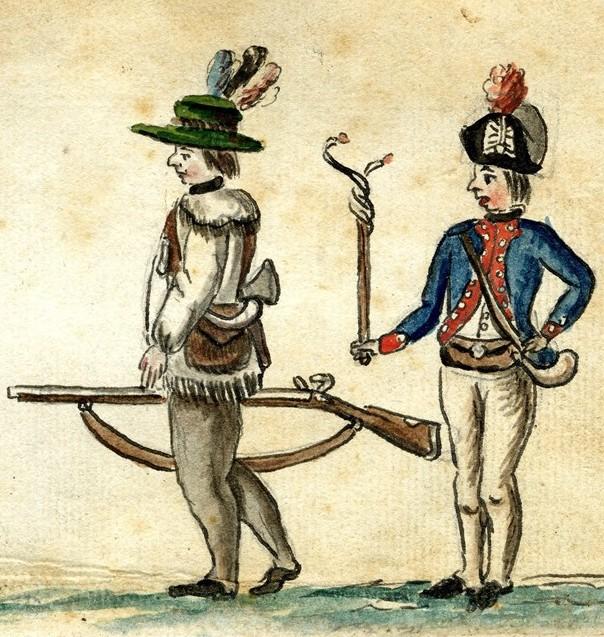Identify the Statements That Describe Loyalists in the American South.
Many loyalists at first urged moderation in the struggle for colonial rights and were only driven into active loyalism by radical fellow colonists who denounced as Tories all who would not join them. The Loyalists lived in each of the colonies in urban and rural areas and they practiced many different trades.

7 Famous Loyalists Of The Revolutionary War Era History
Many of the resentments and antagonisms that fed these conflicts predated the Revolution and the outbreak of war acted as the catalyst they needed to burst forth.

. In particular the middle colonies of New York New Jersey and Pennsylvania had deeply divided populations. Loyalists and Patriots. Identify different groups that participated in the Revolutionary War.
Students complete a chart comparing the two groups. Distribute the Patriot Loyalist or Neutral. Help your students understand the differences in Patriots and Loyalists with this reading comprehension worksheet.
More than simply the losers in the war loyalists were the obverse of the new nations ideology without which the Revolution is incompletely understood. The Patriots at Ninety-Six used classic siege. Students also answer 5 multiple choice questions.
Up to 24 cash back Advantages - Loyalists During The American Revolution. Patriot loyalist or neutral you decide worksheet. In the new United States the Revolution largely reinforced a racial identity based on skin color.
The main disadvantage most believe is that they were fighting against an idea. - Loyalists were joined by numerous slaves in their siding with the crown. Many felt a personal loyalty to the Crown or were afraid that revolution would bring chaos to America.
The Revolutionary War era was a time of immense turmoil for the American colonists no matter where their allegiances lay. The American Revolution in effect created multiple civil wars. The Loyalists supported the idea of America staying a part of England.
The American Revolution in effect created multiple civil wars. What Did the Loyalists Believe. The American Revolution is the subject of this question and the Free Americans who remained loyal to the British during the conflict were colonists who supported the British and were known as Tories or Loyalists.
Students also answer 5 multiple choic. The Loyalists supported the idea of sharing the continent with England. Supplies took months to reach them.
Colonists in the South were much more likely to be pro-British and the Southern Strategy counted on these Loyalist or Tory forces to help them hold territory while the regular army moved on. The besiegers consisted of a thousand Patriots under Nathanael Greene. Loyalists were most numerous in the South New York and Pennsylvania but they did not constitute a majority in any colony.
Help your students understand the differences in Patriots and Loyalists with this reading comprehension worksheet. To understand how ideologies were constructed before and during the Revolutionary War. The rest were South Carolina Loyalist militia.
By comparing and contrasting these two artworks we can examine both sides of the dispute over independence and how the issue directly affected the lives of those involved. Students complete a chart comparing the two groups. Whiteness now a national identity denoted freedom and stood as the key to power.
During the American Revolution an estimated 450000 Americans were loyalists or Tories. During the American Revolution the loyalists were the part of the population of the Thirteen Colonies that did not support the independence movement but on the contrary saw the permanence within the British Empire as the best option. Many agreed with the rebels view that America had suffered wrongs at the hands of Britain.
10 questions ask students to identify if the statement describes Patriots Loyalists or both. 11Identify the statements that describe Loyalists in the American South. - In the American South divisions between loyalists and patriots tended to take on a class - based dynamic.
Indeed despite their class and ethnic differences white revolutionaries stood mostly united in their. Three hundred and fifty of Crugers men were members of regular Loyalist regiments. The Loyalists supported the idea of making each American colony a new country.
An estimated 20 percent of the colonial population was loyalist. 10 questions ask students to identify if the statement describes Patriots Loyalists or both. Blackness more than ever before denoted servile status.
The defenders consisted of five hundred and fifty Loyalists under the command of Lieutenant Colonel John Cruger a New Yorker. 10 questions ask students to identify if the statement describes Patriots Loyalists or both. Those who rebelled.
New York was their stronghold and had more than any. Many of the resentments and antagonisms that fed these conflicts predated the Revolution and the outbreak of war acted as the catalyst they needed to burst forth. New York which the British occupied during the American Revolution had a heavily British culture and may have been as much as half Loyalist.
Large numbers of loyalists from South Carolina fought for the British in the Battle of Camden. Explain Loyalist and Patriot sentiments. If you were fighting in the war you were 3000 miles away from England causing a lack of communication.
As American rebels fought for independence from Britain Loyalists supported the mother country for different reasons. The majority of Loyalists fought in the southern and middle colonies and few were from the northCitation neededdateFebruary 2008 In addition a large number of Americans served in the regular British army and in the Royal Navy. Largest group among the colonists.
As you read each of the documents highlight or underline key phrases and words that address the document-based question. Specifically urban elites and large landowners as well as settlers of. The Loyalists supported the idea of American independence from England.
Even though they had a lot there were some things the British lacked. However some areas and social niches had a greater percentage of Loyalists than others.

Patriots Loyalists And Neutral To Revolution

No comments for "Identify the Statements That Describe Loyalists in the American South."
Post a Comment